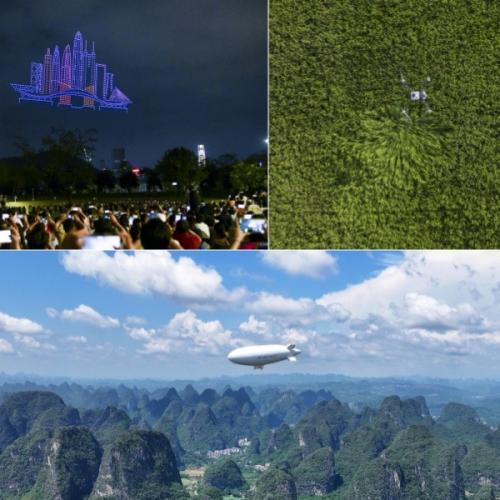



Editor's note: As a highlight of new quality productive forces, China's low-altitude economy is undergoing a transformative evolution, marked by a diverse range of application scenarios, broad market prospects and huge development potential.
The concept of 'Low-altitude Economy' was first proposed academically in 2010, first proposed in policy in 2021, first proposed by the top leaders in 2023, first proposed in law on Jan 1, 2024 and officially included in the national Government Work Report in March, 2024.
Eye-catching low-altitude aircraft in various scenarios in China

Low-altitude aircraft have been widely used in various scenarios in China, including for performance, agriculture, tourism, logistics, medical and emergency rescue.
China's first homegrown AS700 civil manned airship not only plays an important role in low-altitude tourism, but can also be used in multiple scenarios such as logistics, intelligent mapping, emergency rescue and urban security.
Application progress in China
Air taxi

Dubbed as "air taxi", the eVTOL aircraft completed its first inter-city electric air-taxi demonstration flight in South China's Guangdong province on Feb 27, 2024.
The first low-altitude short-haul transport route for passengers between Shenzhen and Zhuhai in the Greater Bay Area opened on April 30, 2024.
The passenger-carrying helicopter route connecting Shanghai Pudong Airport and Jiangsu Kunshan City Terminal opened on Aug 18, 2024.
Low-altitude logistics distribution achievements

In August 2024, Meituan drones began food and emergency delivery services to visitors at the Badaling section of the Great Wall.
Meituan released the fourth generation of new drone models, focusing on the new multi-rotor models of urban low-altitude logistics distribution scenarios on July 5, 2023.
Meituan began self-developing drone technology in 2017 and sent the first order in Shenzhen in 2021, starting normal operations of drone delivery service.
On Dec 2, 2024, an SF Express drone took off from the Wuhan Blood Center, carrying 800 milliliters of "life-saving blood" for surgery to Wuhan Asia General Hospital, a journey that took only 19 minutes. This marked the launch of Wuhan's first low-altitude blood distribution route.
The drone is a product of Phoenix Wings, a cargo drone company of China's delivery giant SF Express. While approaching its destination, the drone can scan a QR code at the center of the parking apron to help it make a precise landing.
Supporting policies in China

National-level
Local level
Broad market prospects

The market scale of China's low-altitude economy is projected to reach 1.5 trillion yuan ($210 billion) by 2025, and 3.5 trillion yuan by 2035, said the National Development and Reform Commission citing data from the Civil Aviation Administration of China.
Sound infrastructure and technical capacity

China has more than 440 drone routes.
5G-A, artificial intelligence, satellite communications and other technologies are also applied to low-altitude economic infrastructure construction.
The number of low-altitude economic invention patent applications in China has increased rapidly from 852 in 2014 to 14,134 in 2023.
Enterprises pursue new quality productive forces through innovation

By the end of March 2024, China had over 69,000 enterprises related to the "low-altitude economy", and the top four provinces with the most companies related to the "low-altitude economy" are Guangdong, Shandong, Shaanxi and Anhui.
What is the low-altitude economy?

The "low-altitude economy" refers to a comprehensive economic form that involves low-altitude flying activities, both manned and unmanned, within the airspace below 3,000 meters, spreading across multiple fields.
If you have any problems with this article, please contact us at app@chinadaily.com.cn and we'll immediately get back to you.